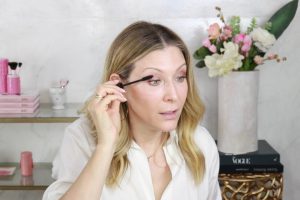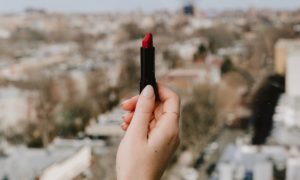TikTok has spawned more beauty trends than we can count, from makeup hacks to skincare advice. The latest one to hit the #ForYou page? Skin cycling. The term, coined by New York City dermatologist Dr. Whitney Bowe last year, is a new way of structuring your evening skincare routine.
Designed to baby your skin barrier — which you might already know is essential for skin health — the trend can offer legit benefits for all skin types, but is especially helpful for those with sensitive skin or dryness.
Here, exactly what it can do for your skin, and how to do it to get the best possible results (that is, calm, healthy, radiant skin).
So, what is skin cycling?
For the uninitiated — or offline — we’ve got you covered. “Skin cycling is a very intentional cadence of nighttime skincare,” says NakedPoppy skin specialist Tara Parenti. “It involves ‘cycling’, or alternating your products so that you aren’t using multiple actives in one night.”
Basically, your skin cycle spans several nights, with each night featuring a different active ingredient or product — essentially giving your skin breaks in between to recover.
While it’s new to social media, it’s not especially new to pros in the skincare world. “This is something that dermatologists and estheticians have recommended for their patients and clients for years,” Parenti says. The upside? You can trust that it has years of expert-approved success to back up its efficacy.
What are the benefits of skin cycling?
For starters, it’s great for newbies. “For individuals who are new to what we would call ‘high-performance’ skincare, this is a great way to maintain the integrity of their skin barrier and overall skin health,” Parenti says.
By “high-performance”, we mean ingredients that pack a punch in terms of their benefits, such as retinol and some exfoliating acids, which usually require gradual acclimation. “Chemical exfoliation uses ingredients such as alpha-hydroxy acids, beta-hydroxy acids, polyhydroxy acids, or enzymes to remove dead skin cells by reacting with the skin and disrupting the bonds holding skin cells together, essentially removing the dead skin cells,” says NakedPoppy research scientist Marisa Plescia. “However, since the face can be a sensitive area, it’s preferred to only exfoliate your face around one or two times a week, as is recommended with skin cycling.”
Similarly, retinol — which is best known for its ability to speed cell turnover to address everything from acne to fine lines — can also be tough to tolerate on a nightly basis. As a result, “keeping your retinol at once or twice a week in the skin cycling protocol helps to minimize the potential side effects of retinol usage, such as dryness and redness,” says Plescia.
Skin cycling can also help if your skin barrier is on the fritz — or just compromised due to good, old genetics. “For individuals who are sensitive or in a current barrier health challenge, it is an ideal way to heal the skin while still being corrective,” Parenti says. “Many don’t realize that their texture, breakouts, and dehydration are due to over-exfoliation.”
Finally, it can stretch out your use of active ingredients, which can often come at a literal cost. “It’s also an approach to skincare that is conscientious of user sophistication, age, lifestyle, and finances — and promotes a more sustainable philosophy in using less skincare, as opposed to piling on tons of layers and actives,” she says.
Who should be skin cycling?
If you’re reading this, you can try skin cycling. While those with a compromised or sensitive skin barrier can (and should) try it, Parenti also highly recommends it for those dealing with new, random, or persistent inflammatory skin conditions, such as irritation, dryness, and breakouts in those who don’t typically get acne. “Chances are that skin just needs a break — and skin cycling is a great way to do that,” she says.
How to skin cycle in your routine
Every skin cycling schedule looks a little different, depending on your skin type, concerns, and how much you want to keep track of — since the cycles can be as short as three nights and as long as five. Ultimately, Parenti says, “you will never use multiple actives in one routine, in one night.”
Whichever cadence you go with, consider your cleanser and moisturizer non-negotiable. For starters, you still need to cleanse the makeup, grime, and excess oil that collected on your skin. As for moisturizer, “it is still essential to use a hydrating and moisturizing product no matter the day — and as a daily step in both your morning and evening skincare routines,” says Plescia. “It’s important to maintain water content within the skin to help strengthen skin barrier protection.”
With that in mind, consider this sample five-night cycling routine, which incorporates both chemical exfoliation and a retinoid.
- Night 1: Incorporate chemical exfoliation. Try Odacité Bioactive Rose Gommage, which uses papaya and pineapple enzymes to shed dead skin cells.
- Night 2: Recovery night. Take a night off from actives and stick with moisturizer only. Plescia recommends a nutrient-dense facial oil like NakedPoppy Revitalizing Organic Facial Oil.
- Night 3: Incorporate a retinol. Use Maya Chia The Straight A Serum – Advanced Gentle Retinol Treatment for its brightening, smoothing benefits.
- Night 4: Recovery night. Repeat Night 2.
- Night 5: Recovery night. Repeat Night 2.
- Take it from the top!
And again, on each night of your skin cycling routine — whatever that looks like — you’ll still cleanse and moisturize as well.
Not sure which active ingredients you need? We’ve got you: Just take the easy, 3-minute NakedPoppy assessment to get your personalized routine.
Possibly the best part of skin cycling? There’s no drawback. The only challenge can be to have patience — but hey, who couldn’t use a little practice? “Skin cycling tests one’s ability to adopt a progressive, rather than aggressive, approach and mindset,” Parenti says. Plus, that’s more sustainable for most of us, anyway.
All told, slow, steady, and simple wins the (healthy skin) race.
Get “shockingly accurate” clean beauty picks. Take your beauty assessment.
Shop the Story:






Comments